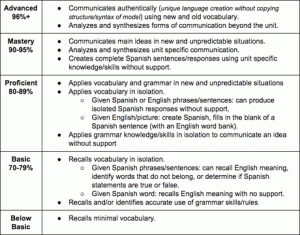Levels of Understanding: Learning That Fits All
Diverse learners require diverse teaching strategies. Student voice and choice lie at the foundation of a differentiated classroom, leading to multiple pathways for student growth.
Your content has been saved!
Go to My Saved Content.Have you ever tried on a "one-size-fits-all" article of clothing? If you happen to be of average height and average weight, then perhaps this size worked for you. However, if you happen to be shorter, taller, weigh less, or weigh more than the average person, then the odds are that the one size that supposedly fits all does not work for you!
The same goes for one-size-fits-all lessons or practice. Think about this for a second. Do all of your students earn the same grade? I'm certain they don't! And yet, many teachers assign the same homework or same practice to all students regardless of individual students' level of readiness. Let's say that I create a practice geared toward proficiency -- maybe for students with a B. This practice might be useful for students with B's or C's. Clearly, this practice is too easy for students with an A and too difficult for students with a D. By assigning this "one size fits some" practice, I just ignored the needs of the advanced and struggling students.
By now, teachers start to think, "Wait a minute! I don't have time to create individual practice for all of my students! Who has time for that?" The truth is, no one has time for that! So the question is how do we develop and embrace a framework that supports creating homework or practice to meet the needs of all learners? In order to reach diverse learners, we need diverse teaching strategies. Student voice and choice lie at the foundation of a differentiated classroom. When voice and choice are honored, the one-size-fits-all model transforms into multiple pathways for student growth.
Here are a few steps to offer multiple pathways for student success.
The Framework: Tiering for Levels of Understanding
A good lesson design includes learning objectives that are visible to students. However, learning objectives alone will not guide students in terms of how they'll need to perform. There are a few tools that can help you tier learning objectives and activities for levels of understanding: Depth of Knowledge chart (PDF), Depth of Knowledge Question Stems (PDF), Bloom's Taxonomy, or Hess' Cognitive Rigor Matrix (PDF). Here's an example that I created for my Spanish students:

It's important to reveal these levels of understanding to students. Too often, students want to know how many points they need to get the next letter grade. These clearly-defined levels of understanding shift the focus from point chasing to knowledge seeking. Without gaining understanding, student learning plateaus or plummets.
The Practice: Tiering Practice for Levels of Understanding
Once you determine what students will need to do for each level of understanding, it's time to create practice that mirrors these levels. This can be accomplished through a variety of strategies, but regardless the method, it is imperative to honor student voice and choice.
Labeling Levels of Understanding
This is one of the simplest ways to tier practice. Levels of understanding can be labeled by clearly identifying ability levels as part of the heading for each section of practice. Students can choose where they need to start based on their own levels of understanding. Some may start with the Basic practice and work through Proficient. Others may start with Proficient and work their way through Advanced. This means that, while all students receive the same paper or practice, they simply choose where to start and end.
Learning Menus
Learning menus offer students voice and choice in how they learn while providing them with purposeful practice. This SlideShare, Multiple Pathways to Student Engagement, offers examples of how to create Think Tac Toe menus as well as additional learning menu styles aligned to levels of understanding.
Anchor Activities
These are practice activities available to students once their work is complete and extra time remains. You can create anchor activities at a designated station in your classroom where students can go for extra practice. In order to foster self-reflection, consider having students identify why they chose the practice they chose. Want to go digital? Consider creating digital playlists with hyperlinks for students to navigate their practice. Sites such as Symbaloo or EdShelf are great platforms for anchor activities.
The Assessments: Tiering for Formative and Summative Assessments
Assessments can be tiered for levels of understanding as well. Formative assessments should build from basic to advanced levels of understanding in order to guide instruction and practice. Summative assessments should embrace all levels of understanding so that both the teacher and student have a clear picture of student learning at the end of a unit of instruction.
These are just a few of many strategies to support diverse learners. The bottom line is that "one size" only fits some students. It is the responsibility of diverse teachers to offer diverse strategies in order to support diverse learners in the classroom.
